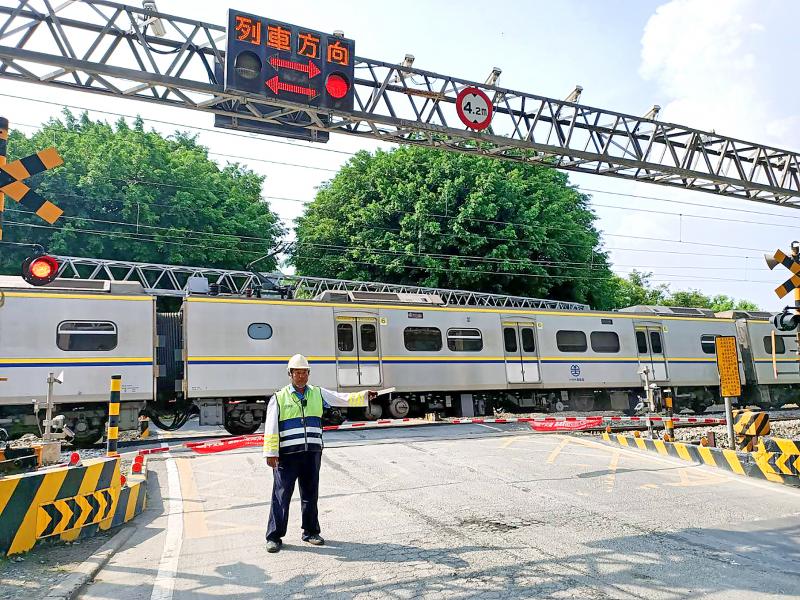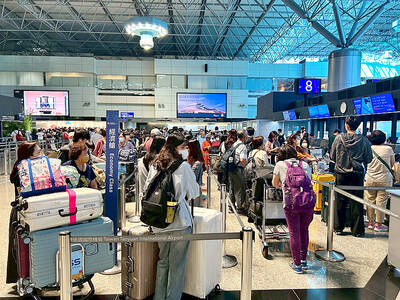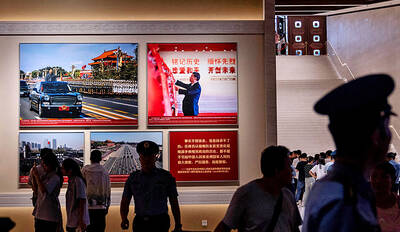Measures to reduce accidents at railroad crossings nationwide are part of a six-year railway safety plan, the Taiwan Railways Administration (TRA) said on Monday.
Accidents at railway crossings fell to only 12 last year, but have rebounded this year, with 11 in the first six months alone, the TRA said.
The measures include installing large signs on gantries above every crossing to inform people that a train is coming and from which direction, it said.

Photo courtesy of the Taiwan Railways Administration
Flashing signals would be installed on both sides of the road at crossings, the agency said, adding that there would be four sets of emergency buttons, up from two.
The safety improvements would be completed by the end of next month, it said.
New automatic systems to detect objects intruding on tracks would be installed at all 293 crossings on its routes, the TRA said.
The new system detects intruding objects using radar and thermal induction technology, which improves its sensitivity, it said.
The current system detects objects between 75cm and 1.5m in height, while the new system detects objects that are from 30cm to 3m tall, the agency said.
When an object is detected, the information would be relayed to train drivers so they can respond quickly to an emergency situation, the TRA said, adding that the system would be activated at 100 crossings by the end of this year.
Systems at the remaining crossings would be activated by the end of next year, it said.
The agency said that 1,200km of fiber optic cabling would be installed along its routes to replace copper cables, which would ensure the reliability and stability of its signal-monitoring system.
The project is to be completed by the end of this year, it said.

Three batches of banana sauce imported from the Philippines were intercepted at the border after they were found to contain the banned industrial dye Orange G, the Food and Drug Administration (FDA) said yesterday. From today through Sept. 2 next year, all seasoning sauces from the Philippines are to be subject to the FDA’s strictest border inspection, meaning 100 percent testing for illegal dyes before entry is allowed, it said in a statement. Orange G is an industrial coloring agent that is not permitted for food use in Taiwan or internationally, said Cheng Wei-chih (鄭維智), head of the FDA’s Northern Center for

The Chinese military has built landing bridge ships designed to expand its amphibious options for a potential assault on Taiwan, but their combat effectiveness is limited due to their high vulnerability, a defense expert said in an analysis published on Monday. Shen Ming-shih (沈明室), a research fellow at the Institute for National Defense and Security Research, said that the deployment of such vessels as part of the Chinese People’s Liberation Army (PLA) Navy’s East Sea Fleet signals a strong focus on Taiwan. However, the ships are highly vulnerable to precision strikes, which means they could be destroyed before they achieve their intended

About 4.2 million tourist arrivals were recorded in the first half of this year, a 10 percent increase from the same period last year, the Tourism Administration said yesterday. The growth continues to be consistent, with the fourth quarter of this year expected to be the peak in Taiwan, the agency said, adding that it plans to promote Taiwan overseas via partnerships and major events. From January to June, 9.14 million international departures were recorded from Taiwan, an 11 percent increase from the same period last year, with 3.3 million headed for Japan, 1.52 million for China and 832,962 to South Korea,

REWRITING HISTORY: China has been advocating a ‘correct’ interpretation of the victory over Japan that brings the CCP’s contributions to the forefront, an expert said An elderly Chinese war veteran’s shin still bears the mark of a bullet wound he sustained when fighting the Japanese as a teenager, a year before the end of World War II. Eighty years on, Li Jinshui’s scar remains as testimony to the bravery of Chinese troops in a conflict that killed millions of their people. However, the story behind China’s overthrow of the brutal Japanese occupation is deeply contested. Historians broadly agree that credit for victory lies primarily with the Chinese Nationalist Party (KMT)-led Republic of China (ROC) Army. Its leader, Chiang Kai-shek (蔣介石), fled to Taiwan in 1949 after losing a